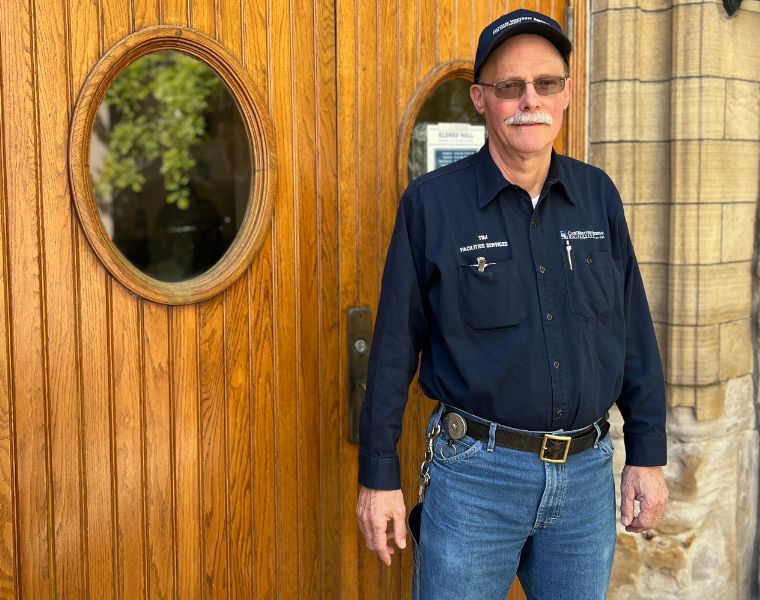If you’ve ever stepped over the thresholds of Adelbert Gym, Harkness Chapel or Eldred Hall, chances are you’ve admired the detailed carpentry of their wooden doors.
The artistic elements are the product of Tim Logsdon’s hard work. A carpenter at Case Western Reserve University since 1980, Logsdon skillfully transformed piles of lumber into passages to some of the university’s most notable buildings. And today, after 44 years, he will retire from CWRU having left a visible impression on structures across campus.
Though you might wonder if 44 years in the same job would be repetitive, Logsdon’s days were anything but, with tasks ranging from extensive woodworking projects to affixing photos to walls in office spaces. It’s that breadth of work that kept him happy through the years.
One notable project was the restoration of the Board of Trustees’ meeting table that was damaged in the 1991 Adelbert Hall fire. The surface had been completely burned through, but Logsdon carefully repaired it in the mid-1990s so it could be used once again. While the board now meets at a new table, Logsdon most recently saw the original used in Thwing Center’s Cleveland Room. Logsdon’s work on the table was highlighted in an article in the campus newspaper at the time—a copy of which he recently discovered as he cleaned out his campus locker.
Another major project was a retirement gift for former CWRU President Agnar Pytte, a specially designed letter stand to match the furniture in his new home. Logsdon’s work earned him and his wife an invitation to the black-tie retirement dinner the Board of Trustees planned for Pytte.
Building meaning
While Logsdon enjoyed the more extensive projects he’s had the chance to contribute to over the years, he also found meaning in the smaller tasks that had an impact on the day-to-day lives of faculty, staff and students across campus, such as fastening a bulletin board to the wall for an employee.
“It kind of makes their day because that’s their world, and now you’ve helped them out,” he said.
For a carpenter, working at CWRU gave him unique opportunities that he wouldn’t have found in roles elsewhere, such as helping construct the setting for the 2004 vice presidential debate between Dick Cheney and John Edwards.
“I’ve met people and seen things the average carpenter wouldn’t,” said Logsdon, who has several family members who worked in the trades.
It’s far from anything he would have expected when he responded to a newspaper ad for a carpenter back in 1980 amidst a job shortage.
“The work and being part of what the university is has been a source of pride from early on,” Logsdon said.
During his tenure at CWRU, Logsdon witnessed the university’s exponential growth, both in physical size and national stature. It was a point of pride—and proven to be exactly what he’d hoped for back on his first day in 1980: a good place to work until the day he would retire.
As he closes his locker for the final time today, he does so knowing it was.

